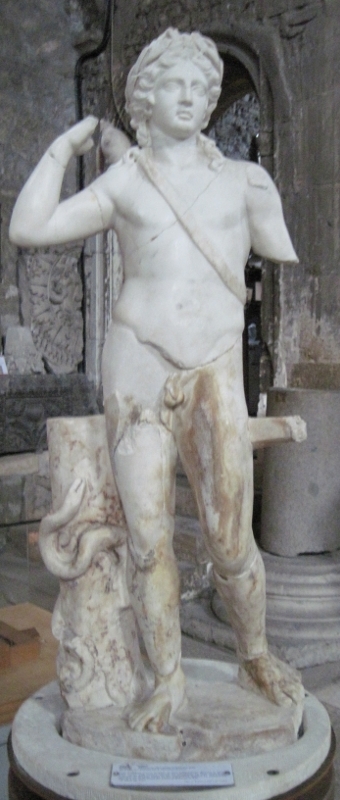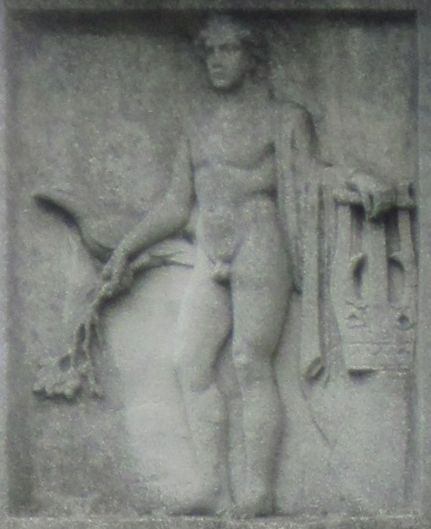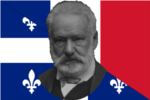
Apollo drawing an arrow from his quiver (the bow has disappeared along with his left hand). Near him is the python of Delphi. He is nude but for a crown of laurels. Marble statue from Vienne, Isère.
(Musée Saint-Pierre, Vienne, 2nd century ce)
Origins and family · Attributes · Regional diversity (Belinos · Borvo · Grannus · Maponus · Moritasgus) · Myth of the Hyperboreans
“Following [Mercury] they worship Apollo, Mars, Jupiter, and Minerva. Respecting these deities they have for the most part the same belief as other nations: that Apollo averts diseases...”
— Julius Cæsar (summarizing Posidonius)[1]

The divine Julius’ formula is too simplistic for both Gaul and the “other nations”. The classical Apollo is a very complex god: as inspirer of oracles, patron of music and arts, and sun god, he is the “brilliant god” par excellence.[2] His medical function is attested as early as Homer, who has Apollo spreading plague among the Argives with his deadly arrows. The heroes of the Iliad propitiate his favour and thus halt the plague.[3] From this point on, Apollo takes on a key role as a healer, even though his curative works are often realized by other deities in his entourage, including Æsculapius and Hygieia. We should note that in Gaul, other gods also protect against disease, including Mars and even Hercules. The Gaulish Apollo has a special affinity for healing hot springs.
Apollo’s origins and affinities reveal much about his own identity as an object of worship. Apollo’s twin sister is Diana, who shares with him a talent for archery, a certain androgyny, and associations with heavenly bodies (in Apollo’s case the Sun, in Diana’s the Moon). Their parents are Jupiter and Latona (a goddess whose cult was most active in Lycia, in the present-day Turkish counties of Antalya and Muğla). According to the myth, Juno forbade the Earth from giving Latona a place to give birth, with the result that the hapless mother had to flee to Delos—an island that, at that time, merely floated along without being anchored to the Earth.[4]
Apollo had many lovers, including nymphs and mortals of both sexes. The most famous of this is surely Daphne, who repulsed his advances and transformed herself into a laurel tree. From then on, the laurel has been the tree sacred to Apollo.
In Greek mythology, Æsculapius is Apollo’s son by the nymph Coronis,[5] while Hygieia is the daughter of Æsculapius. However, the goddess who bears Hygieia’s attributes in Gaul—the great Ðirona—seems to have a closer connection with the god. Modern scholars describe her as Apollo’s consort; at any rate, she is clearly his partner (leaving the word its ambiguities).
In Apollo’s entourage are the Muses—goddesses who preside over music, poetry, theatre, and all the other arts dear to Apollo. While the Muses have hardly any organized cult in Gaul, they are nevertheless a familiar motif in household mosaics. The hero Orpheus was also fathered by Apollo.
Gaulish depictions frequently show Apollo in close collaboration with his younger brother, the great Mercury. According to the Homeric Hymns, the child Mercury invented the lyre in order to give it to Apollo in compensation for a theft of cattle.[6] From this point begins their longstanding collaboration. The famous alter of Reims shows Mercury and Apollo on either side of Cernunnos, the chthonic god presiding over prosperity and animal life. Here were guardians of three qualities essential to earthly life—health, fertility and prosperity—which the Gauls no doubt presented as complementary.

Apollo’s depictions are often characterized by the androgynous suppleness of the god’s figure; he often wears his hair long, and his face is invariably young and beardless. His nearly constant attribute is the lyre, an instrument of which Apollo is the acknowledged master (to Marsyas’ chagrin...Cf. the story of Apollo and Marsyas given by P. Ouidius Naso, Fasti VI.649–710.). Incidentally, while the lyre itself is no longer much played, it is the organological ancester of such ubiquitous instruments as the guitar, the violin and the harp as well as the qanun and dulcimer. Among the other attributes of Apollo are the bow and arrow, the laurel tree (a remembrance of the departed Daphne), and the tripod of Delphi, which symbolizes Apollo’s role as inspirer of oracles. We must not forget his favourite animals, such as the python, the griffin and the crow (and sometimes other birds such as the swan).[7]
Cult representations of the Gaulish Apollo remain fairly faithful to their Hellenic inspiration. The same could hardly be said of the depictions of Apollo on Gaulish coinage. The most influential model for Celtic gold coins was the stater of Philip II of Macedon, which featured the head of Apollo on the obverse and a horseman on the reverse. La Tène art transformed these into a huge variety of abstract designs.[8]
As Julius Cæsar indicates, the Gauls worshipped a healing god who was identified with Apollo probably as early as the time of Posidonius.[9] The Celtic epithets that were attributed to Apollo probably carry on those names given to Apollo in pre-Roman times. Archæological remains confirm that a key role of the Gaulish Apollo is to preside over thermal springs. Some famous examples are to be found at Grand (whose name is thought to derive from the epithet Grannus), Bourbonne-les-Bains, Bourbon-Lancy (both of which derive from the epithet Borvo), and Chamalières (where he was worshipped as Map[on]os Arveriatis).
The list below lays out all of Apollo’s epithets in Gaul that I am aware of.[10]
Some of these names can be more or less explained through their Celtic etymologies, namely Anextlomarus (the Great Protector), Veriogodumnus (most iogo- of the earth), Vindonnus (root uind- ’white, blessèd’), Virotutis (Truth).[11] Others are more obscure: Cobledulitauus, Dunocaratiacus, Siannus. There is even a dedication to Apollo Flaccus ‘flaccid’, a title as bizarre in meaning in Latin as in English. (Its phonological characteristics exclude the possibility of flaccus being a Celtic word.)
The epithet Maponus or ‘great son’ (attested at Saint-Rémy-de-Provence and in Britain) has excited a greal deal of scholarly discussion thanks to its obvious resemblence to Mabon. The latter—a minor character in Welsh mythology—is linked in turn to Óengus Óc, also known as the Macc Óc or ‘young son’, one of the most illustrious figures in Irish mythology. The Macc Óc’s adventures are known from the Tochmarc Étaíne (the Wooing of Étaín), the Aisling Óenguso (the Dream of Óengus), and the late text Toruigheacht Dhiarmada agus Ghráinne (the Pursuit of Diarmuid and Gráinne). On the basis of these associations, the Irish god has been freely assimilated to the Gaulish Apollo and vice versa. We should however bear in mind the great distances—more than 430 km and at least five centuries—that separate ancient Gaul from mediæval Ireland. Still, the temptation to link the Macc Óc’s rich mythology with Apollon Maponus is perhaps irresistible.
Despite the observable variation, Celtic epithets of Apollo fall mainly into three zones: the Grannus zone in the north (also associated with Ðirona), the Borvo zone in Burgundy (of which Apollo Moritasgus seems to be a local variant), and the Belinos zone in the south.
The leading manifestation of the Gaulish Apollo north of Burgundy is Apollon Grannus, and/or that Apollo whose partner is Ðirona. (Most often, inscriptions invoke ‘Apollo Grannus’ alone, or else ‘Apollo and Ðirona’ with no mention of Grannus. There are, however, strong reasons to identify these two deities, including a few exceptional inscriptions that invoke both Apollo Grannus and Ðirona.) One inscription explicitly identifies Apollo Grannus with Phœbus—the solar manifestation of the classical Apollo. Others identify him as Amarcolitanus (a topical epithet?) and Mogounus (evidently related to the Germano-British god Moguns).
The name Grannus is not easy to interpret. X. Delamarre observes that many scholars have sought to derive Grannus from a common root with the Irish grían ‘sun’, attributing this to a “solar monomania of certain mythologists”. The vowel, and the doubling of the n, make this hypothesis very doubtful. A derivation from an Indo-European root meaning ‘beard’ also has its difficulties—not least the fact that Apollo Grannus is always depicted as clean-shaven! Jürgen Zeidler’s study defends an etymology of *gwhr-snó that makes “reference ... to the heat of the sun and its healing qualities”.[12] Healing, thermalism, solar connations ... here indeed is an exact summary of what is known about the Gaulish Apollo.
At least at Limoges, a festival of ten nights was dedicated to Grannus. An inscription in that city mentions the decamnoctiacis Granni (ten nights of Grannus),[13] which we will have cause to mention again below.
Inscriptions dedicated to Apollo Grannus:
In a mid-Gaulish zone centred around today’s Burgundy, we find inscriptions in honour of the god Borvo or Bormo, a name to be interpreted simply as ‘hot spring’.[14] Not surprisingly, Borvo’s greatest sanctuaries were two thermal springs, Bourbon-Lancy and Bourbonne-les-Bains, that preserve the god’s name to this day. An inscription at Entrains-sur-Nohain (Nièvre) memorializes the fulfilment of a vow to Augustus, to the god Borvo and to Candidus, ‘the candid’, no doubt a minor deity in Apollo’s train who calls to mind Apollo Virotutis ‘truth’ and Apollo’s role as revealer of the truth through oracles.[15] Entrains has revealed a monumental sanctuary including a circular fanum and an enormous statue of Apollo playing the lyre while seated on a throne (the lyre is decorated with a griffin). The seated posture is as unusual as the statue’s great dimensions.
Unlike Apollo Grannus, Apollo Borvo most frequently consorts with the goddess Damona, whose name is to be translated as the ‘Great Cow’[16] (presumably without the insulting connotations that such a name would have in English!).
Borvo shares Damona’s partnership with Apollo Moritasgus. The epithet Moritasgus is restricted to the area of Alesia (a Gaulish site pregnant with historical memory—not least that of the great battle that decided whether Gaul’s future would lie with Cæsar or with Vercingetorix). Since, conversely, the name Borvo is not found in the Alesian region, it seems logical to identify Moritasgus as the local avatar of Borvo. This name is to be interpreted as ‘Sea Badger’[17]—rather a curious appellation in this mountainous area located so far from the sea.
Inscriptions dedicated to Borvo and Apollo Moritasgus:
The cult of Belinos is most strongly attested in northern Italy; most inscriptions in honour of this god come from Aquileia (or else Altino, both very close to Venice). Still, nine inscriptions also commemorate his cult in Gaul, including texts in Latin, Greek and Gaulish. One comes from Clermont-Ferrand, another from Nîmes, and the rest from Provence. Looking beyond epigraphy, we see the poet Ausonius—a native of Bordeaux who wrote in a highly stylized Latin—salute his Baiocassian friend as the descendant of priests of Belenus.[18] While insriptions in Italy sometimes explicitly identify Belinos with Apollo, this is not the case in Gaul (or in Rætia, where two inscriptions are attested).
The spelling of this god’s name is quite variable, regardless of the alphabet in question (Greek or Latin). The first vowel is always e in Latin letters, but varies between ε and η in Greek. The former indicates a short vowel, the latter a long one. We have three inscriptions with a double ll; the other six have a single l or λ. As for the second vowel, it can be e or i in Latin, and ε, η or ει in Greek (this last digraph indicates a long i sound in Gaul). X. Delamarre interprets the name as ‘Master of Power’, unlike many scholars who have sought a root meaning ‘brilliant’ but whose etymology is doubtful.[19]
Inscriptions in honour of Belinos :
There is a female partner of Belinos in some depictions; her name so far is unknown.
Among the feast days of Apollo is one known from a Gaulish inscription, namely the decamnoctiacis Granni (ten nights of Grannus) that were celebrated at least at Limoges.[13] Internal evidence does not reveal which these ten nights were; however, certain cirumstantial evidence leads me to suspect a date in mid-August.
In Rome, mid-July saw the Games of Apollo, followed by the Market Fair of Apollo.
On the 23rd of September (the birthday of the divine Augustus), there was commemorated the dedication of the temple of Apollo on the Field of Mars. The brilliant Augustus, by the way, considered Apollo as his particular patron and benefactor, especially after the battle of Actium.
Apollo’s mythology grounds him in a mythical mild North. Every nineteen years, Apollo would return to the island of the Hyperboreans (Great Britain?), an idyllic land beyond the north winds whose inhabitants were all, as Diodorus Siculus tells us, practically Apollo’s priests. The amber that was brought to Apollo’s sanctuary at Delos originated in the lands around the Baltic Sea.[18] Even the Greek imagination located Apollo in a North mediated by Celtic territory.
From the summary above, we can state three great varieties of the Gaulish Apollo that were, if not identical, certainly in complementary distribution. Each of the three presided, as Posidonius tells us, over the curing of disease, and one of the god’s favourite methods of doing this was through healing hot springs. At the same time, Apollo’s significance in Gaul far surpasses his medical function. He is a sun god (I should say that he is represented in the role of sun god, rather than that he is the Sun god). His brilliance is to be seen in the artistic inspiration he gives to writers, musicians and dancers (especially via the Muses), but also in the oracular inspiration of which he is the source and the gage of truthfulness. Jealous of his prerogatives and certain of his preeminence, Apollo is also gentle, seductive, and devoted to beauty.

